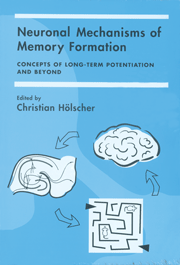Book contents
- Frontmatter
- Contents
- Contributors
- Introduction: Long-Term Potentiation as a Model for Memory Mechanisms: The Story So Far
- Section One Long-Term Potentiation In Vitro and In Vivo: How Can We Fine-Tune the Current Models for Memory Formation?
- Section Two There is More to the Picture Than Long-Term Potentiation: Theta or Gamma Oscillations in the Brain and the Facilitation of Synaptic Plasticity
- Section Three Making Models from Empirical Data of Synaptic Plasticity
- 9 Toward a Physiologic Explanation of Behavioral Data on Human Memory: The Role of Theta-Gamma Oscillations and NMDAR-Dependent LTP
- 10 Neuronal Networks, Synaptic Plasticity, and Memory Systems in Primates
- 11 Revisiting the LTP Orthodoxy: Plasticity versus Pathology
- 12 Long-Term Potentiation and Associative Learning: Can the Mechanism Subserve the Process?
- Section Four Setting the Stage for Memory Formation: Stress, Arousal, and Attention
- Section Five Transgenic Mice as Tools to Unravel the Mechanisms of Memory Formation
- Conclusions and Future Targets
- Index
11 - Revisiting the LTP Orthodoxy: Plasticity versus Pathology
Published online by Cambridge University Press: 13 October 2009
- Frontmatter
- Contents
- Contributors
- Introduction: Long-Term Potentiation as a Model for Memory Mechanisms: The Story So Far
- Section One Long-Term Potentiation In Vitro and In Vivo: How Can We Fine-Tune the Current Models for Memory Formation?
- Section Two There is More to the Picture Than Long-Term Potentiation: Theta or Gamma Oscillations in the Brain and the Facilitation of Synaptic Plasticity
- Section Three Making Models from Empirical Data of Synaptic Plasticity
- 9 Toward a Physiologic Explanation of Behavioral Data on Human Memory: The Role of Theta-Gamma Oscillations and NMDAR-Dependent LTP
- 10 Neuronal Networks, Synaptic Plasticity, and Memory Systems in Primates
- 11 Revisiting the LTP Orthodoxy: Plasticity versus Pathology
- 12 Long-Term Potentiation and Associative Learning: Can the Mechanism Subserve the Process?
- Section Four Setting the Stage for Memory Formation: Stress, Arousal, and Attention
- Section Five Transgenic Mice as Tools to Unravel the Mechanisms of Memory Formation
- Conclusions and Future Targets
- Index
Summary
SUMMARY
Long-term potentiation (LTP) continues to be the most intensely studied model of neuroplasticity, and is viewed by many as a substrate of learning. Other potential roles of LTP, however, have not received widespread discussion in the field. In this chapter, we will evaluate the LTP phenomena, discuss the putative connection to learning, and expand the discussion to include the participation of LTP and kindling in some forms of neuronal pathology. The available evidence appears to support a role for LTP in a continuum of events reflecting different levels of neural activity ranging from long-term depression (LTD) through LTP and kindling and culminating in cellular degeneration. In place of LTP as the substrate of learning at a neuronal level, we outline a model in which multiple levels of neural organization exert mutual control such that activity and modifiability at any level are controlled by those levels above and below.
Research is essentially a dialogue with Nature. The important thing is not to wonder about Nature's answer—for she is always honest—but to closely examine your question to her.
A. Szent-GyorgiIntroduction
It is now over a quarter of a century since long-term potentiation (LTP) was first described (Bliss and Lomo, 1973). Initially it was viewed, rightly with great excitement, as an interesting phenomenon possibly linked to learning. Now it is frequently declared in unqualified terms to be the “cellular basis of learning and/or memory” (e.g., “LTP is a learning mechanism,” Fanselow, 1997) and its study virtually dominates the field of neuronal plasticity. Those new to the neurosciences would be forgiven for assuming that this transition occurred because the relationship between LTP and learning or memory had been experimentally demonstrated.
Information
- Type
- Chapter
- Information
- Neuronal Mechanisms of Memory FormationConcepts of Long-term Potentiation and Beyond, pp. 263 - 293Publisher: Cambridge University PressPrint publication year: 2000
